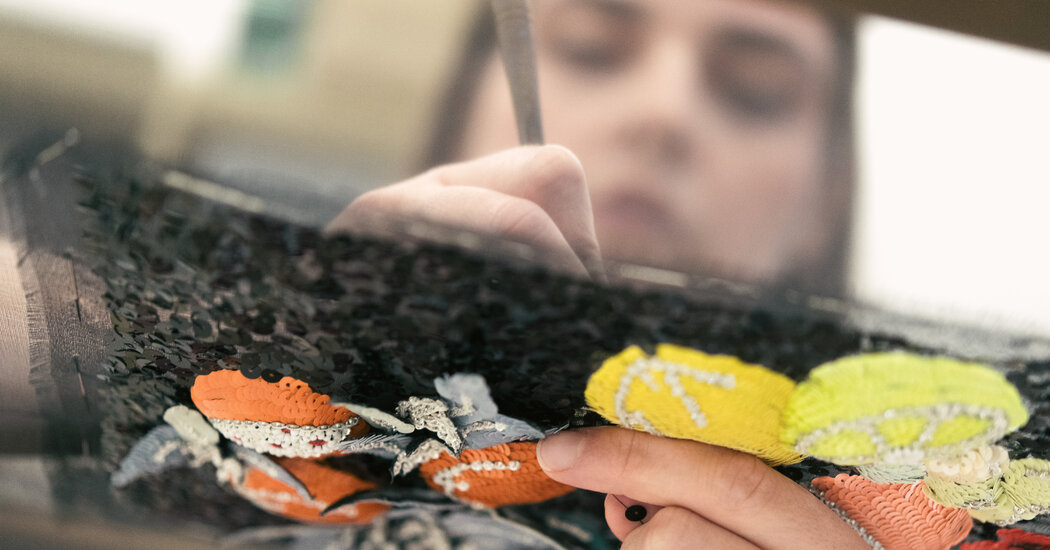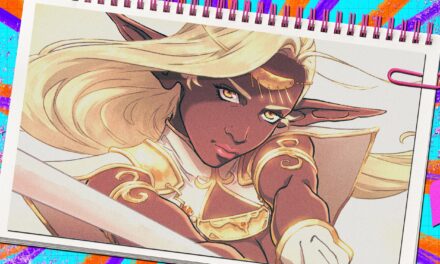
Lesage, a French specialty house now owned by Chanel, has been using sequins, beads and metallic threads to create explosions of color for decades.
“Embroidery is to haute couture what fireworks are to Bastille Day.”
No one seems to know precisely when François Lesage said this, although the speculation at Maison Lesage is that it was sometime in the 1980s when embroidery was very much in vogue in haute couture collections.
Case in point: One embellishment created for a fall couture outfit comprised 30,000 transparent gold glass beads, 10,000 light-gold cuvettes (curved sequins), 1,000 black sequins and 5,169 roses in gemstones such as ruby and amethysts. “It’s an allover blouse,” said Hubert Barrère, Lesage’s artistic director, “embroidered with bouquets of blackberries, sequins and tubes covered with gold leaf and blackberries represented by plum, garnet and jet crystals.”
Much like the fireworks of Mr. Lesage’s quote — which appears in a book by the fashion writer Patrick Mauriès — the piece was exploding with color, shimmering and shining from all angles.
Throughout its nearly 100 years of history, Maison Lesage has collaborated with the world’s premier fashion houses, including Christian Dior, Yves Saint Laurent and Chanel, which acquired Lesage in 2002.
Today, the company’s 70 artisans — along with the workers of 10 other specialty ateliers including the couture jewelry-maker Goossens and the feather and flowers business Lemarié — work at Le 19M, a two-year-old seven-level complex in the 19th Arrondissement, on Paris’s northern edge.
But the somewhat remote location does not mean Lesage is forgotten. In September, King Charles III of Britain came by with Queen Camilla during his state visit to France for a tour of the facilities that included trying their hands at different skills.
And every year Chanel stages a métiers d’art show in a different city — in 2022, it was Dakar, Senegal — to showcase the savoir-faire of its artisans. On Dec. 7, the catwalk is scheduled in Manchester, the northern English city that built its wealth in the 19th century on cotton and the textile industry.
“Lesage and all the maisons d’art are part of the future of fashion,” Bruno Pavlovsky, Chanel’s president of fashion, wrote in an email, “and the contribution of each maison is key, not just at Chanel, but if you look at shows today, everyone wants to value the unique savoir-faire.”
This past summer I spent an afternoon in Lesage’s shimmering world, where sequins, beads, metallic threads and more come together with the skill of the petites mains (in English, tiny hands), as the skilled seamstresses of Parisian fashion houses are called.
At Lesage, the artisans are predominantly women from varied backgrounds. Some are graduates of École Lesage, the in-house embroidery school, although its training program, which can involve as much as 150 hours of instruction, is not a prerequisite for a job. One worker now on staff, for example, formerly taught history and geography.
“The most difficult part is to make,” Mr. Barrère said. “We’re talking about humans, not machines.”
Mr. Barrère said it takes at least 100 hours to make an embroidery for a simple ready-to-wear garment. “In haute couture, it’s 600, 800, 1,000 or 2,000 hours of work, it depends,” he continued. “Each time you multiply it with the price per hour and it becomes very, very expensive.”
The creative process at Lesage is both collaborative and intensely personal. Here is how it works:
Conveying a Theme
Fashion collections usually have themes, and Lesage artisans work with designers and their teams to turn those themes into embroidery.
“Each project is unique,” Mr. Barrère said — and to explain it, he described the work behind the Chanel Cruise collection, designed by Virginie Viard, Chanel’s creative director, and presented in May on the Paramount Studios lot in Los Angeles.
Just one month before the show, Ms. Viard said “she would like something with movement, something free and also cinematic, something glamorous” from Lesage, Mr. Barrère said. “The movement — it’s very simple when you see what’s going on at Rodeo Drive, with all the guys and girls rollerblading and people in shorts. It’s not Chanel at all, but we’re going to make it Chanel.
“And it’s hot in Los Angeles, there’s palm trees, ice cream, pastel colors.”
As a result, the collection featured a lot of color. “Color gradients were the new black at Chanel that season, like sunsets,” he said. “And we came up with embroideries with flowers, palm trees, ice cream, disco balls. And fireworks in gold sequins on a dress.”
Ideas such as those are then sewn as samples, about 10 to 15 centimeters in height (four inches to six inches), and shown to the designer.
“It goes fast, very fast,” Mr. Barrère said. “Every month and a half, there’s a new collection, not counting special projects. And each collection requires about 50 to 100 new samples to get five or 10 models.” (We were walking into Lesage’s archive, a large room lined with thousands of small black drawers, each bearing a collection label indicating the season and year, going back as far as the 1920s. Like “the Swiss bank,” he said humorously.)
Prick and Pounce
Once the designer has chosen a sample, it goes through a pattern-making process that ends with a version on tracing paper.
In the atelier’s drawing room, Gaëlle — a designer Lesage would identify only by her first name, a common practice in many French luxury businesses — demonstrated the next step, using blue and red pencil to identify which areas should be sewn in which colors. Once she finished drawing, she used a hand-held machine called a stitcher to punch tiny holes in the tracing paper. The frequency and spacing of the holes indicate where the embroiderers should sew.
After some preparations, she laid the tracing paper on the fabric. Using a poncette, a small spongelike tool made from felt remnants from another Le 19M resident, the French hat-maker Maison Michel, she rubbed powder (white, black or gray, depending on the color of the fabric) through the holes and onto the fabric. The design then was fixed with an alcohol spray.
Embroider
To make a pattern come to life, embroiderers use a wide range of threads and materials as well as sewing techniques.
Léa, an embroidery apprentice, demonstrated the Lunéville stitch. Named for the town in northeastern France where it originated, the stitch is done exclusively on the reverse side of the fabric, using a tool with a fishhook-like device at one end that is called a Lunéville crochet. Once finished, she flipped the fabric over, and a colorful floral motif appeared.
(Lesage also uses another technique called needlepoint embroidery, a manual process in which stitch after stitch of thread, pearl or sequin embellishment is applied to the fabric.)
Léa was working on an embroidery for Chanel’s fall 2023 couture collection, shown alongside the Seine in July. The piece eventually would require 5,170 chalk and ivory glass beads, 29,500 sequins in colors such as porcelain red, light yellow, ocher, light gray, sea green and metallic black, as well as 1,995 pierced red crystal chips.
Lesage also has a textile design workshop for tweed. It was set up in 1996 to work on Chanel’s ready-to-wear collections (Coco Chanel famously used the men’s wear fabric for her women’s designs), but since 2008 Lesage has been designing tweeds for numerous brands and private customers.
In the workshop, a pastel tweed with tie-dyed silk ribbons was displayed, just one of Chanel’s Cruise collection fabrics from the Los Angeles show. And Louise, a textile designer, was working on a highly textured tweed made of lace that was being woven with shades of mauve, violet, black and brown and embellished with hints of navy, silver and green, for the Chanel fall couture show.
One Hundred Years
Lesage was established in 1924, when Albert and Marie-Louise Lesage, embroidery specialists who worked with designers such as Madeleine Vionnet, bought out a Parisian workshop called Michonet.
When Albert Lesage died in 1949, their son François, who was living in California and creating embroideries for Hollywood films, returned to France to help his mother with the business. By the early 1960s, he had formed a creative relationship with Yves Saint Laurent and, by the mid-1980s, Karl Lagerfeld was designing for Chanel and he wanted to use the house’s services, too.
Chanel, aware by 1985 that French specialty houses were struggling, bought the button and jewelry maker Desrues. And then in 1997, it created Paraffection, a subsidiary to preserve and promote the houses under its ownership; in 2002, Lesage was added to the group.
“Chanel was a visionary before anyone else, they understood that French luxury depended on creativity but also savoir-faire,” Mr. Barrère said. “And that these artisans’ houses were very fragile and needed to be bought out to prevent the skills from being lost, not to turn them into museum showcases.”
(In 1993 Lesage Intérieurs, part of the Lesage company, was established to make large hand-embroidered pieces such as wall panels for architects, museums and decorators. The work is done at the Vastrakala workshop in Chennai, India, founded by François’s son, Jean-François, the business’s artistic director, and his Indian associates.)
Drawing and Design
As a young adult, Mr. Barrère studied law, but his real passion was drawing. So he moved to Paris from Brittany and studied fashion at École de la Chambre Syndicale de la Couture Parisienne, now known as Institut Français de la Mode.
“I dreamed of being Yves Saint Laurent,” he said. “But in the end, it wasn’t possible because I didn’t have any money and I ended up working for an embroiderer who paid me to learn embroidery design,” referring to Guy Vermont. (In 2012, Dior bought the Vermont atelier.)
In 1995, Mr. Barrère set up his own design company, making corsets and embroidery and working with designers such as Alexander McQueen, John Galliano and Stella McCartney. (He created the corset for Madonna’s wedding dress in 2000.) He also was artistic director of the Parisian embroidery atelier Hurel from 1997 to 2011, during which time he worked with Chanel.
In 2011, “the president of Chanel asked me to succeed François Lesage, who was very unwell,” Mr. Barrère said. “Unfortunately, he died the day I arrived.”
Mr. Barrère also works on outside projects, such as a recent collaboration with the Opéra Comique in Paris on sets and costumes for “Zemire et Azor,” a retelling of Beauty and the Beast.
Of the hundreds of projects he has worked on at Lesage, Mr. Barrère remembers some as particularly challenging.
“We made Chanel suits in 3-D printers,” he said, for the fall 2015 couture show, based on a suit worn by the model and designer Inès de la Fressange in the ’80s and ’90s, all black with sequins and a quilted finish.
A canvas was created then scanned, and computer engineers reconstructed the suit. “We made embroideries that imagined the quilted pattern,” he said, displaying a sample that, when stretched, popped up into three-dimensional cubic shapes.
Lesage also has a project that is close to his heart: transmitting its savoir-faire to the younger generation. The company regularly offers workshops for teenagers, often for students from the atelier’s working-class neighborhood.
“If you discover them, our trades are deeply moving,” Mr. Barrère said. “And in our increasingly fast-paced world, with its virtual gizmos, it’s an interlude of humanity. And that is reassuring.”




